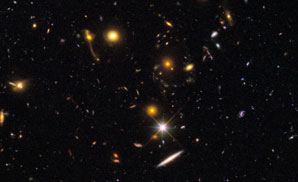Nobel voor heelal dat in ijs eindigt

De Nobelprijs oganisatie vertelt over de winnaars en hunbetekenis het volgende:
What will be the final destiny of the Universe? Probably it willend in ice, if we are to believe this year’s Nobel Laureates inPhysics. They have studied several dozen exploding stars, calledsupernovae, and discovered that the Universe is expanding at anever-accelerating rate. The discovery came as a complete surpriseeven to the Laureates themselves.
In 1998, cosmology was shaken at its foundations as two researchteams presented their findings. Headed by SaulPerlmutter, one of the teams had set to work in 1988.Brian Schmidt headed another team, launched at theend of 1994, where Adam Riess was to play acrucial role.
The research teams raced to map the Universe by locating themost distant supernovae. More sophisticated telescopes on theground and in space, as well as more powerful computers and newdigital imaging sensors (CCD, Nobel Prize in Physics in 2009),opened the possibility in the 1990s to add more pieces to thecosmological puzzle.
The teams used a particular kind of supernova, called type Iasupernova. It is an explosion of an old compact star that is asheavy as the Sun but as small as the Earth. A single such supernovacan emit as much light as a whole galaxy. All in all, the tworesearch teams found over 50 distant supernovae whose light wasweaker than expected – this was a sign that the expansion of theUniverse was accelerating. The potential pitfalls had beennumerous, and the scientists found reassurance in the fact thatboth groups had reached the same astonishing conclusion.
For almost a century, the Universe has been known to beexpanding as a consequence of the Big Bang about 14 billion yearsago. However, the discovery that this expansion is accelerating isastounding. If the expansion will continue to speed up the Universewill end in ice.
The acceleration is thought to be driven by dark energy, butwhat that dark energy is remains an enigma – perhaps the greatestin physics today. What is known is that dark energy constitutesabout three quarters of the Universe. Therefore the findings of the2011 Nobel Laureates in Physics have helped to unveil a Universethat to a large extent is unknown to science. And everything ispossible again.
En wie zijn deze drie winnaars?
Ze zijn opvallend jong voor een ergelijke prijs. Adam Riess isvan 1969.
Saul Perlmutter, U.S. citizen. Born 1959 inChampaign-Urbana, IL, USA. Ph.D. 1986 from University ofCalifornia, Berkeley, USA. Head of the Supernova Cosmology Project,Professor of Astrophysics, Lawrence Berkeley National Laboratoryand University of California, Berkeley, CA, USA.
Brian P. Schmidt, U.S. and Australian citizen.Born 1967 in Missoula, MT, USA. Ph.D. 1993 from Harvard University,Cambridge, MA, USA. Head of the High-z Supernova Search Team,Distinguished Professor, Australian National University, WestonCreek, Australia.
msowww.anu.edu.au/~brian/
Adam G. Riess, U.S. citizen. Born 1969 inWashington, DC, USA. Ph.D. 1996 from Harvard University, Cambridge,MA, USA. Professor of Astronomy and Physics, Johns HopkinsUniversity and Space Telescope Science Institute, Baltimore, MD,USA.
Meest Gelezen
Vrouwen houden universiteit draaiende, maar krijgen daarvoor geen waardering
Wederom intimidatie van journalisten door universiteit, nu in Delft
Hbo-docent wil wel rolmodel zijn, maar niet eigen moreel kompas opdringen
‘Burgerschapsonderwijs moet ook verplicht worden in hbo en wo’
Raad van State: laat taaltoets nog niet gelden voor hbo-opleidingen
